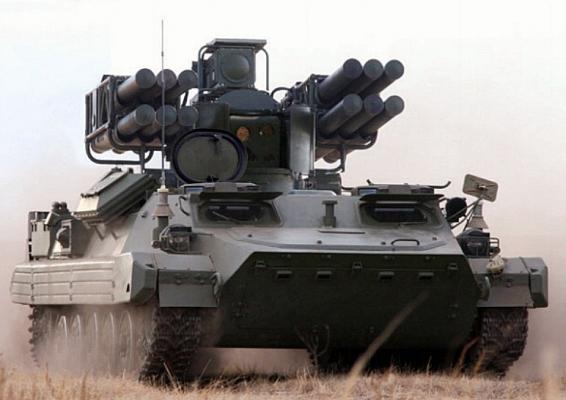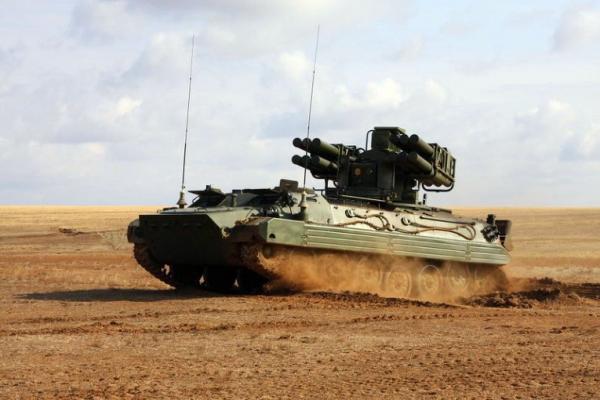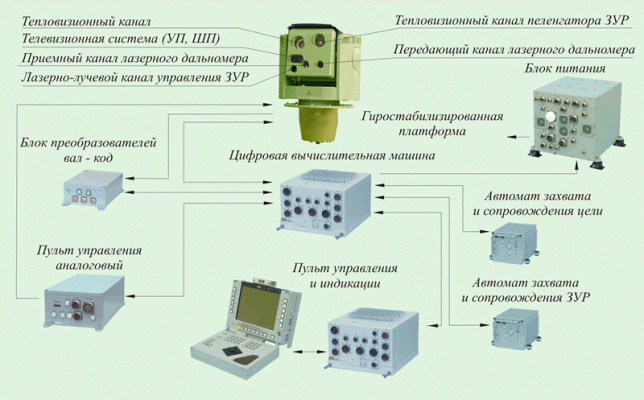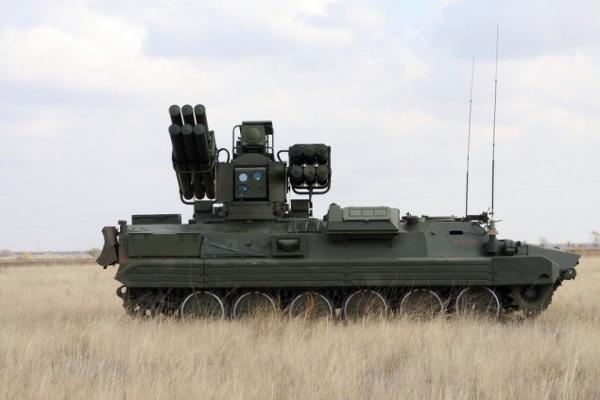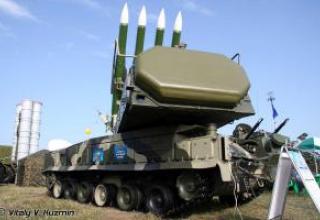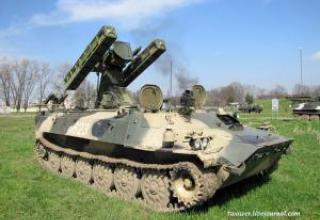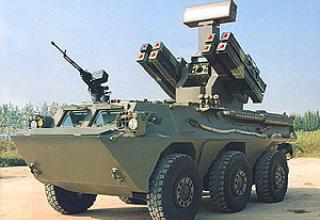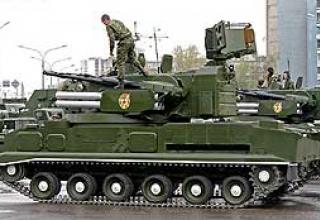The Sosna anti-aircraft missile system (SAM) is designed to protect military units in any form of combat, including on the march, from the means of air attack and reconnaissance of the probable enemy.
The complex provides defeat of helicopters, aircraft, vehicles, cruise missiles, remotely operated vehicles and lightly armored ground vehicles at any time of the day in conditions of limited visibility in the presence of natural and artificial obstacles at a range up to 10 km.
The main developer of the complex is OJSC "Nudelman Design Bureau of Precision Engineering" . The development of the complex has been conducted since 1987. The main directions of work were to increase the combat stability of the complex, reducing the cost of the combat vehicle. Increasing the combat stability of the SAM system was achieved by abandoning the use of radar detection systems in order to reduce vulnerability to enemy anti-radar weapons.
Sosna" SAM systems have a modular design, the components of which can be installed on various carriers with a carrying capacity of at least 3.5 t, as well as in stationary versions. At the customer's request, the complex can be manufactured as a combined missile and gun variant (see photo), or only as a canon or rocket.
The Russian army is offered a missile version of the complex on the chassis of the multi-purpose light armored tractor MTLB.
For the first time the complex in the form of posters was demonstrated at the International Weapons Exhibition in Abu Dhabi IDEX-2003 and MAKS-2003, later various versions and components of the complex were repeatedly exhibited at various exhibition sites.
Sosna" SAM system is fully unified with "Palma" ship missile and artillery system by its main structural elements - means of destruction and control. The Sosna-R missile of the complex is also used in the Arrow-10M4 SAM system.
As of 2013, the complex was on trial.
Composition:
The combat module of the complex includes:
- two bags of six Sosna-R missiles in transport and launch containers,
- optical-electronic control system,
- digital computer system,
- guidance mechanisms,
- the power supply system.
Pine Rocket - two-stage rocket with a detachable engine. After leaving the container, the missile is controlled by a radio command system, which brings it to the line of sight, then the starting engine is separated and the interference-proof laser guidance system is activated.
Battle unit: shrapnel rod to engage on the span, armour-piercing rod to engage in direct hits. Exploder: Non-contact laser with a continuous circular radiation pattern and adaptive blast time.
The missile does not require additional checks or tests during its lifetime. The small weight of the rocket allowed to exclude the transport and charging machine from the complex.
Initially, the complex used an anti-aircraft two-stage guided missile 9M337 (see photo_1, photo_2, photo_3), now the Sosna SAM system is equipped with SAM 9M340 (9M340E) (see photo_1, photo_2, photo_3, photo_4, photo_5).
The 9M337 missile is capable of engaging targets flying at altitudes up to 3500 meters. Its range is between 1.3 and 8 km, with a maximum flight time of 11 seconds. The combat unit weighs 5 kg. The weight of the missile in the transport and launch container is 36 kg, without the container - 25 ... 26 kg.
Opto-electronic control system of the complex has high accuracy characteristics of target coordinates determination, interference and stealth and provides automated combat operation of the complex from the moment of target detection to their firing.
It includes: optoelectronic module (OEM), digital computer system, drives for horizontal and vertical guidance of weapons, control and display panel, power supply unit, automatic systems for acquisition and tracking of SAM and target.
OEM is placed on a gyrostabilized platform and serves for autonomous or according to external target designation (radar, superior control) target detection, automatic or semi-automatic tracking, high-precision determination of its coordinates (angles of sighting the target and range) and their issuance to a digital computer system for shooting.
The OEM consists of:
- the television system,
- thermal imaging channel,
- laser rangefinder with beam deflection device,
- laser beam channel control equipment for the missile,
- the missile's direction finder's thermal imaging channel,
- climate control device.
Autonomous target detection is carried out by a television channel with a wide field of view, and the distance to it is determined by a laser rangefinder, working in automatic mode.
Rockets and the anti-aircraft system itself are protected from interference by several methods implemented at the construction level. Thus, the location of the laser receiver in the rear of the missile does not allow to distort or jam the control signal. Interference immunity of the ground part of the complex is provided by a narrow field of view of TV and thermal imaging channels, as well as the use of special computing algorithms that allow to identify the target by its characteristics. The complex is practically insensitive to radar and optical suppression means used by the enemy.
The combination of the high level of missile characteristics and the control system makes it possible to obtain large kill zones (see diagram). Sosna" SAM system can be used as part of a battery, including mixed composition, receiving target designation from the battery control station or commander's vehicle, as well as autonomously. The Sosna SAM system battery, using sector search, can do without external target designation, providing all-around visibility and target detection in passive mode, which makes it impossible to attack the PRR.
Characteristics:
| Target range, km | 1.3-10 |
| Flight height of targets, m | 2-5000 |
| The reaction time, s | 5 |
| Recharging time, min | 10 |
| Opto-electronic control system | |
| Range of pointing angles, deg: azimuth around the corner |
±178 between -20 and 82 |
| Maximum angular speed, deg/c | 50 |
| Maximum angular acceleration, deg/s2 | 150 |
| Field of vision, deg: television system thermal imaging channel |
2.0х3.0 /6.5х9.0 1.67х2.5 /8.0х12.0 |
| Range of target tracking at MDV=15km, p=80%, km: aircrafts helicopters cruise missiles armored facilities |
16-30 10-14 8-12 8 |
| Accuracy (SKO): stabilizations, mrad coordinate determination, mrad range finding, m LD guidelines homing LLKU, mrad |
0.07 0.2 5.0 0.1 0.08-0.12 |
| Pine Rocket. | |
| Defeat zone, km: in range: in altitude: |
10 5 |
| Flight speed, m/s: maximum pointing average |
875 565 |
| Total mass BC, kg | 6.9 |
| The mass of ZUR, m: launch at the TIC |
30.6 42 |
| Caliber, mm: before separation after separation |
132 72 |
| Length of ZUR, mm: in flight at the TIC |
2317 2400 |
Testing:
From September 1 to November 28, 1945, the Nb.W.42 trophy mortar was tested at the Red Army State Automobile and Space Administration. The tests were carried out on the basis of the order of the Deputy Chief of SAKP, Major-General of the Engineering and Artillery Service of Serebryakov under the program of the range - SAKP task №4410.
In the report No 0116 dated 19.1.46 the description of the device and operation of the Wgr.42 mine, L.J.gr.Z23nA fuse and the mortar were given. Data on the heap and range, as well as theoretical calculations of internal and external ballistics are given. In addition, the report contains the results of analysis of the hull materials and equipment. The test manager was Captain Lerner.
The purpose of the tests was to determine:
- basic characteristics of the mortar and the mine Wgr.42 /description of the device, operation and purpose/.
- Intraballistic characteristics Wgr.42 /powder gas pressure and charge burn time/.
- aerodynamic characteristics Wgr.42 (wind tunnel blowing).
- The impact and maximum mine speed and the nature of mine buildup in the active area.
- Maximum range at 10°, 20°, 30° and 45° elevation angles.
- The mine's blast and fragmentation effect on the target.
- the system's strength, stability and rate of fire.
When measuring five minutes on centering belts, the projectile caliber was 214 mm, so the report suggested "counting the caliber not 210 mm as usual, but 214 mm".
The conclusions of report No. 0116 were as follows:
- The 210 mm Wgr.42 rocket projectile with the M-13UK missile was characterized by simplicity, cheapness and availability of materials that were used for its production. It was noted that the Germans considered it possible for missile chambers to allow deformation at maximum pressure beyond the elastic limits, i.e. the chambers were calculated not on the elastic limit, but on the temporary resistance to rupture with a margin of strength of the order n=1.5.
- Manufacturing of dinitroglycol powders for rocket charges had advantage in comparison with manufacturing of nitroglycerine powders. As glycol was based on cheap raw material base (vegetable oils), and glycerin was mainly produced from animal fats.
During the study of the mine, it was disassembled into structural elements. See their photos: photo 1, photo 2, photo 3, photo 4, photo 5, photo 6, photo 7.
From August 8th till August 13th 1945 at the State Mine Stockpile of Ukraine there were conducted shooting to determine experimental data for drawing up tables of shooting. Shots were fired at an elevation angle of 10°, 20°, 30° and 45° (maximum possible elevation angle).
The mortar was simultaneously loaded with 5 shells. The mortar was fired in single shots. The charge was corrected after each shot, and the shoot down rate was insignificant. Due to lack of German mortar sight, side aiming was made with MP-41 sight.
As a result of tests it was received:
- The puchiness and range of the 210 mm Wgr.42 missile did not differ from the characteristics of the domestic M-13UK projectile. When the angle of Ө decreases (elevation angle) the heap drops sharply especially in range: gri Ө=10° the range of 2650m and the WDX = 1/17 was obtained; WDX = 1/58, at Ө=45° the range of 8000 m and the WDX = 1/88; WDX = 1/76.
- The effect of the Wgr.42 mine on the target was undoubtedly more powerful than that of the M-13UK, as the 210mm projectile carried 9.27 kg of explosives, while the M-13UK carried 4.55 kg. However, the Wgr.42 has a smaller fill factor /WB to passive weight ratio than the M-13UK. The M-13UK had a filling ratio of 13% and Wgr.42 had a filling ratio of 10%.
- The design of the Wgr.42 mine was characterized by the simplicity, affordability and accessibility of the materials used in its manufacture.
- Calculation of internal ballistics showed the following results: at charge temperature - 40°C the pressure in the chamber was equal to 106 kg/cm2, at charge temperature +40°C the pressure was equal to 325 kg/cm2. This gave grounds to suppose that the rocket charge will work at low temperatures and will not break the chamber at high ones.
- The chemical composition and physical characteristics of the gunpowder rocket charge did not differ from glycol powders, which were adopted in German artillery. Powder strength and caloric value were of the same order as M-13UK rocket charges, but the use of glycol undoubtedly extended the raw material base of the powder production.
- The design of the 210-mm 5-barrel Nb.W.42 mortar carriage did not differ from that of the 150-mm 6-barrel Nb.W.41 mortar carriage.
- The maneuverability and ease of operation are satisfactory, but the power of the 210 mm mortar salvo is about 1.5 times smaller than that of the BM-13. For one salvo of 5-barrel mortar ejected 46 kg ВВ, and installation BM-13 - 73 kg ВВ.
It was concluded that the design of the 210 mm Nb.W.42 rocket launcher and its projectile was found to be successful, both in combat and operational terms.
The mortar was disassembled into its structural elements during its study. See their photographs: photo 1, photo 2, photo 3, photo 4, photo 5, photo 6, photo 7, photo 8.
Sources:
- Зенитный ракетный комплекс Сосна /ОАО «НПО «Высокоточные комплексы»/
- Зенитный ракетный комплекс "Сосна" /КБточмаш им. А.Э. Нудельмана /
- Зенитная управляемая ракета Сосна-Р /ОАО «НПО «Высокоточные комплексы»/
- Зенитный ракетный комплекс 'Cосна' /ОАО 'КБточмаш им. А. Э. Нудельмана'/
- Комплексы ПВО ближнего действия с зенитными ракетами «Сосна-Р»
- http://strangernn.livejournal.com/1287812.html
